This article is a panel discussion with questions and answers on face-lift technique.
Gaylon McCollough, Stephen Perkins, and J. Regan Thomas address questions for discussion and debate:
- 1.
Who is not a candidate for facelift?
- 2.
- 3.
- 4.
Which, if any, face-lifting techniques have been proved to provide the longest lasting result?
- 5.
- 6.
Stephen Perkins presents videos of his facelift technique: Sequential Submental Excision and Plication of Subplatysmal Fat and Platysma; Undermining post auricular neck skin flap in rhytidectomy; Submentalplasty in Rhytidectomy; SMAS imbrication; and Submental and Jowl Liposuction in Rhytidectomy. Available at : http://www.facialplastic.theclinics.com
Who is not a candidate for facelift?
M c Collough
Patients who are not in good physical and/or mental health or those who present to a facial plastic surgeon with unrealistic expectations are not good candidates for any appearance-altering surgery. On a more global scale, a patient whose face requires more—or less—than what a “one-size-fits-all” facelift can provide is not a candidate for such a procedure…except in certain circumstances.
Some lifestyle habits affect eligibility for certain types of facelifts and ancillary procedures. Patients who use nicotine in any form are not good candidates for procedures that require extensive skin undermining. However, nicotine use should not automatically disqualify patients from rejuvenation procedures. Short flaps (ie, minimal skin elevation in the appropriate anatomic regions) with suspension of the underlying superficial muscular aponeurotic system (SMAS) and minimal tension on the skin may be an acceptable alternative, as long as the patient understands that by limiting the procedure the overall result will be compromised.
Nicotine users must also understand that flap necrosis and unsightly scars are known risks and must be willing to accept them, in advance of surgery. In all cases, the surgeon should stress abstinence from nicotine for a minimum of 2 weeks before, and after, surgery. Oral niacin (in doses that produce a flush 4 times daily) and topical nitroglycerine paste applied over the undermined areas may be beneficial, especially should the blood supply to any facial flap become questionable.
Thomas
The ideal candidate for a facelift would be an individual whose facial appearance is characterized best by a strong angular bony skeleton with a normal or high positioned hyoid complex. The patient should be at near ideal weight with minimal facial and submental fat and appropriate facial skin elasticity. The ideal patient would have relatively smooth non-sun-damaged skin and be without deep rhytids. Certainly the ideal patient would be a healthy individual without systemic disease and would be psychologically realistic and well motivated, whose goal for surgery is improvement and not perfection. Thus the patient who is not an ideal candidate for facelift would be a patient who does not fulfill these ideal patient characteristics in a significant manner. Also note that it is important that the patient stop taking medications that would have an anticoagulant effect, including aspirin or nonsteroidal antiinflammatory drugs and vitamin E. Smoking has been demonstrated to impede healing, and the patient should quit smoking for at least 3 to 6 months before surgery.
Perkins
Individuals who are not candidates for facelift include
- •
Active smokers ( Fig. 1 )
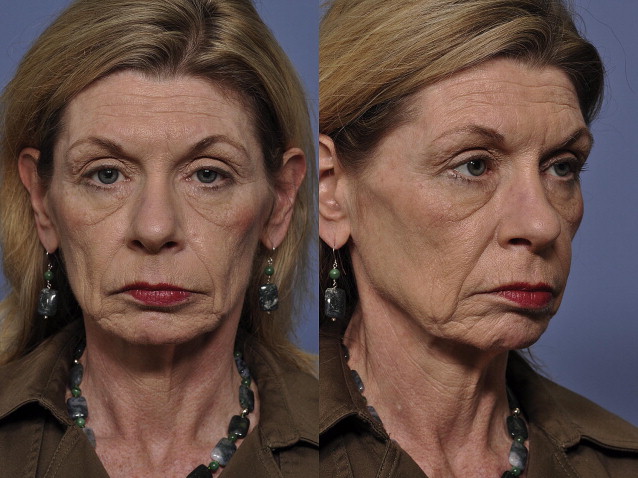
Fig. 1
A 57-year-old woman who desired face and neck rejuvenation but is a recalcitrant 2-pack-per-day cigarette smoker.
- •
Patients who could be in the middle of a life-changing situation (ie, divorce) or who are emotionally unstable and unrealistic and feel that the surgery will improve their life situation
- •
Obese patients, particularly those who are not controlling their weight and have large fluctuations or plan a significant weight loss in the next 3 to 6 months following surgery ( Fig. 2 )
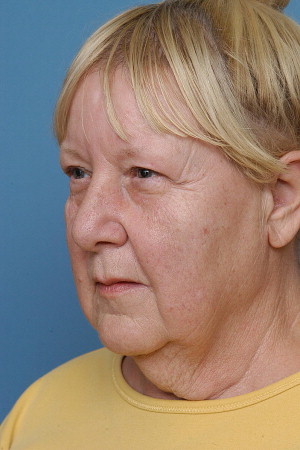
Fig. 2
A 60-year-old woman who is markedly overweight and recently underwent bariatric surgery who desires a neck-lift. At present, this obese patient is not a candidate for facelift surgery until she loses her proposed weight.
- •
Patients unable to tolerate either deep sedation or general anesthesia or who are medically not cleared for surgery for cardiac or other reasons
- •
Patients who have active vasculitis or autoimmune diseases specifically related to the facial skin, such as facial scleroderma
- •
Patients on chemotherapy or a chemotherapeutic type medication controlling their autoimmune disease
- •
Patients with a history of full course radiation to the preauricular and infra-auricular neck skin, that is, those who have compromised vascularity due to chronic radiation or long-term previous chronic radiation exposure
The additional category of poor candidates for facelift should also be noted:
- •
Patients with a low hyoid, producing a very obtuse cervicomental angle, may not achieve a result or one that they expect to obtain. This is true in addition to patients who have markedly weak chins, small mandibles, or thick heavy skin ( Figs. 3 and 4 ). Those patients who have extremely ptotic submandibular glands may be disappointed in their neckline result after facelift because of these glands becoming more obvious.
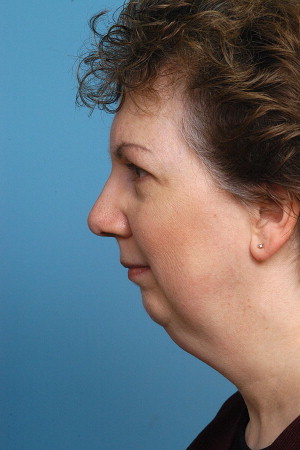
Fig. 3
A 57-year-old preoperative facelift patient with microgenia and a very low hyoid is a poor candidate for facelift surgery.
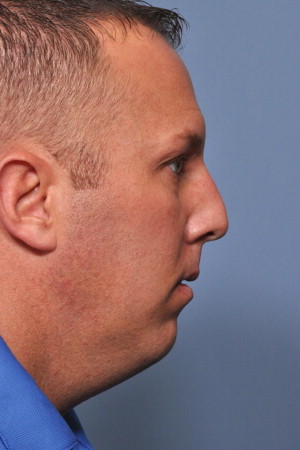
Fig. 4
A 42-year-old man with a weak chin and a low hyoid desires a “sharp” neckline. He remains a poor candidate for significant improvement in his neck from facelift surgery.
- •
Patients with very deep nasolabial grooves and prominent cheek mounds and folds are not ideal for this procedure because the facelift procedure itself does not adequately correct this and the patient may well feel that this is what a facelift does when it, in fact, does not improve that region (see Figs. 2 and 3 ).
A facelift can safely be performed on patients who are poor candidates as long as structural augmentation is added and/or they are completely realistic and are shown the results that are obtainable with their anatomy before the surgery.
Of the various approaches to facelift, do any truly add advantages to an SMAS technique (ie, deep plane facelift)?
M c Collough
The so-called deep plane facelift has created confusion within plastic surgical circles, for it is, simply, an extension of the same SMAS suspension procedures that many facial plastic surgeons have been performing since the late 1970s. The principle difference in the most well-known version of the technique is that the sub-SMAS dissection is carried farther into the cheek and neck than was described in articles published by this author, and others, in the early 1980s.
In all primary lifts, and in every subsequent lift in which it is possible to raise an SMAS flap, the SMAS should be freed beyond the anterior border of the parotid gland and far enough anteriorly and inferiorly to allow for upward and backward movement of the cheek, lower face, and neck (refer to Fig. 36 in the section “Facelift Approaches and Techniques from the Masters”).
When the posterior margin of the newly developed SMAS flap is tugged on with surgical forceps, the surgeon should witness upward and backward movement of the cheek and neck tissues. In my experience, any dissection beyond this point of mobilization is fruitless and increases the risk of injury to branches of the facial nerve.
Thomas
Having tried other approaches through the years, including deep plane facelift, it was my personal observation that an SMAS facelift with 2 vector approach with appropriate submental correction gives the best results. These observations have been documented by others in the literature, including, more recently, the study by Bassichis and Becker in Archives of Facial Plastic Surgery . I describe my techniques at the end of the panel discussion.
Perkins
There are a few advantages to performing facelift techniques that do not require wider subcutaneous skin undermining. The rate of hematoma is not as high with a limited subcutaneous flap like that used in a deep plane classic technique. In addition, the vascular side of the skin flap is a little bit more robust with a shorter skin undermining and a deeper elevation of the SMAS. This may be an advantage in prior smokers. These advantages, however, in my opinion, do not outweigh the benefits of an extended SMAS approach, which takes advantage of not only extended elevation of the SMAS like the deep plane does but also adequate skin undermining for a second vector redraping.
Although the SMAS imbrication technique can dramatically improve the jowl, it provides minimal improvement in the melolabial fold of the midface. Claims of midface-lifting improving this area have not been found to be true. The midface can be defined as the portion of the cheek that encompasses the area between the lower eyelid and the level of the oral commissure. Injectable fillers are advantageous in improving this area. A midfacelift is a procedure that may improve it somewhat but not much.
Extended SMAS facelift with the modified deep plane technique can incorporate dissection just below the zygomatic buttress up over the malar eminence, releasing malar dermal attachments superficial to the zygomaticus muscle and into the midcheek if necessary. Not all patients require elevation of the SMAS in this region. Once good mobilization of the jowl and midcheek tissues has been accomplished with extended SMAS undermining, further dissection into the midcheek may not be necessary. Theoretically, extending the dissection in this region increases the risk of injury to the zygomatic and buccal branches of the facial nerve.
Of the various approaches to facelift, do any truly add advantages to an SMAS technique (ie, deep plane facelift)?
M c Collough
The so-called deep plane facelift has created confusion within plastic surgical circles, for it is, simply, an extension of the same SMAS suspension procedures that many facial plastic surgeons have been performing since the late 1970s. The principle difference in the most well-known version of the technique is that the sub-SMAS dissection is carried farther into the cheek and neck than was described in articles published by this author, and others, in the early 1980s.
In all primary lifts, and in every subsequent lift in which it is possible to raise an SMAS flap, the SMAS should be freed beyond the anterior border of the parotid gland and far enough anteriorly and inferiorly to allow for upward and backward movement of the cheek, lower face, and neck (refer to Fig. 36 in the section “Facelift Approaches and Techniques from the Masters”).
When the posterior margin of the newly developed SMAS flap is tugged on with surgical forceps, the surgeon should witness upward and backward movement of the cheek and neck tissues. In my experience, any dissection beyond this point of mobilization is fruitless and increases the risk of injury to branches of the facial nerve.
Thomas
Having tried other approaches through the years, including deep plane facelift, it was my personal observation that an SMAS facelift with 2 vector approach with appropriate submental correction gives the best results. These observations have been documented by others in the literature, including, more recently, the study by Bassichis and Becker in Archives of Facial Plastic Surgery . I describe my techniques at the end of the panel discussion.
Perkins
There are a few advantages to performing facelift techniques that do not require wider subcutaneous skin undermining. The rate of hematoma is not as high with a limited subcutaneous flap like that used in a deep plane classic technique. In addition, the vascular side of the skin flap is a little bit more robust with a shorter skin undermining and a deeper elevation of the SMAS. This may be an advantage in prior smokers. These advantages, however, in my opinion, do not outweigh the benefits of an extended SMAS approach, which takes advantage of not only extended elevation of the SMAS like the deep plane does but also adequate skin undermining for a second vector redraping.
Although the SMAS imbrication technique can dramatically improve the jowl, it provides minimal improvement in the melolabial fold of the midface. Claims of midface-lifting improving this area have not been found to be true. The midface can be defined as the portion of the cheek that encompasses the area between the lower eyelid and the level of the oral commissure. Injectable fillers are advantageous in improving this area. A midfacelift is a procedure that may improve it somewhat but not much.
Extended SMAS facelift with the modified deep plane technique can incorporate dissection just below the zygomatic buttress up over the malar eminence, releasing malar dermal attachments superficial to the zygomaticus muscle and into the midcheek if necessary. Not all patients require elevation of the SMAS in this region. Once good mobilization of the jowl and midcheek tissues has been accomplished with extended SMAS undermining, further dissection into the midcheek may not be necessary. Theoretically, extending the dissection in this region increases the risk of injury to the zygomatic and buccal branches of the facial nerve.
What techniques are most effective in managing the neckline in face-lifting and in what sequence should these be performed?
M c Collough
As is the case for other areas for which a facelift is indicated, diagnosis precedes treatment. The etiology of an undesirable neckline must be determined. Is it caused by loose skin? Is fat involved? How does the anatomic relationship of the hyoid and thyroid cartilage to the mandible contribute to the cervicomental angle?
If the hyoid bone and thyroid cartilage are titled forward, producing an obtuse cervicomental angle, there is not a lot that can be done (safely) to correct it. If, however, these structures have a vertical orientation, and it is determined that fat is contributing to the problem, fat should be removed with direct excision and/or liposuction. In some cases, it is helpful to remove subplatysmal fat as well.
If the edges of platysmal muscles are divergent (producing platysmal banding), a platysmaplasty (suturing the divergent edges together in the midline) is the most reliable method of correcting the problem. In some cases, a myectomy (removing a V-shaped portion of the muscle perpendicular to the leading edge of the platysmal muscle) may be sufficient. Whenever platysmaplasty is performed, the skin of the neck should be undermined from side to side, connecting the submental wound with the postauricular dissection on each side of the face; otherwise a “cobra deformity” is likely to be noted after swelling subsides.
In virtually all facelifts performed by this author, SMAS suspension in the cheek and posterior neck regions is performed, providing additional improvement in the cervicomental angle. In this author’s experience, to obtain optimal improvement of the cervicomental angle, the postauricular incision should be carried posteriorly and inferiorly along the occipital hairline. Experience has shown that when the postauricular incision does not extend to this point, SMAS is not supported to the occipital fascia and the skin is not undermined (as is advocated in some short scar facelifts); as much as 7 cm of skin can be left behind, leading to inadequate treatment of the skin of the neck.
When the neck needs to be addressed at the time of face-lifting, I address it first, performing the procedures mentioned earlier. Then, I perform a cheek/neck-lift with SMAS suspension and skin removal.
The bottom line is that minimally invasive techniques do not provide long-term improvement of the anterior neck, requiring that the surgeon (or a colleague) will often be asked by the patient to perform additional surgery within months after the first surgery.
Thomas
Most patients benefit from a combination of submental liposuction, removing the adipose content of the mandibular line and submental area combined with tightening of the platysmal layer. These are the 2 maneuvers that most frequently contribute to an aesthetic neckline ( Figs. 5–7 ).
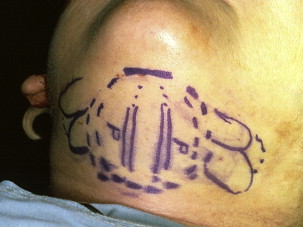
Perkins
Surgery to improve the neckline requires operating on the neckline itself. Facelift techniques that do not directly approach the anterior neck often fail to improve the neck in most patients. Platysmal laxity, cervical liposis, and midline submental fat cannot be adequately addressed solely through a preauricular incision of any type. The foundation for a pleasing cervical mental angle is the platysmal “sling” that is created by midline platysmal placation and posterior anchoring of the platysmal/SMAS flap ( Fig. 8 ). This is a key element in achieving an excellent and a lasting cervical mental angle and good neckline in face-lifting. Often this is really important for patients who are seeking rejuvenation of their face and neck.
I prefer to perform submental/jowl liposuction and corset platysmaplasty at the beginning of the case for several reasons. This is very important because I have tried to do the platysmal tightening after having posteriorly pulled the platysmal and have had many lateral recurrent platysmal bands occur because of inadequate formation of the corset with subsequent sling. I always elevate the neck skin before making the preauricular incision. With this technique, it is easier to approximate the muscles in the midline before they have been pulled posteriorly. Also, extremely important, I prefer to have a strong platysmal “unit” before advancing the platysmal posteriorly. I use the platysmal portion of the SMAS-platysma flap as a sling and do not excise it. I attach it to the posterior mastoid periosteum, as described in the synopsis of my procedure section.
As noted in the face-lifting article by Patel and Perkins, this sequential cauterization, excision, and suturing of the platysmal and submental fat from the mentum and submental incision, posteriorly to the submental angle, creates a firm anterior corset that sets the stage for bilateral posterior suspension and imbrication of the platysma. Some contouring at the cervical mental angle from the wedge excision of the platysmal and subplatysmal fat in this area only may be required in heavier necks to actually create the angle.
The senior author (S.P.) has found that aggressive techniques in the region of the neck have dramatically improved the overall initial long-term results for the neck portion of the rhytidectomy with thus a much happier patient population overall.
Liposuction of the neck and jowls is an essential part of creating a sharp neckline ( Fig. 9 ). Overzealous liposuctioning can create contour irregularities and an oversculpted look; however, most women have some cervical liposis and fat in the jowl region that cannot be corrected with SMAS and platysmal work alone. When performed correctly, liposuction is an excellent additional technique to improve the results not only of the neckline but also of the jawline in face-lifting.
Which, if any, face-lifting techniques have been proved to provide the longest lasting result?
M c Collough
After having performed more than 5000 facelifts, I do believe that some variations of the procedure (particularly those that suspend the deeper tissues in the face and neck with fascia-fascia sutures) enhance both short- and long-term results. Other techniques and principles that are beneficial include the following:
- 1.
Selective low-pressure crisscross liposuction ( Fig. 10 ) along the mandibular margins to remove fatty tissue in the jowl region
Fig. 10
( Left and right ) Multidirectional low-pressure suction-assisted lipectomy.
- 2.
Excisional lipectomy and low-pressure liposuction in the submental region to remove unwanted fat
- 3.
Anterior platysmaplasty in necks with prominent platysmal banding and in necks with an obtuse cervicomental angle ( Fig. 11 )
Fig. 11
An example of anterior platysmaplasty with side-to-side elevation of neck flaps in a patient coded as SQ-3, V-2, CH-3, Mar-2, Ne-4, DL-3, FX-2, WR-2.
- 4.
In virtually all facelifts, I excise a strip of fat and fascia overlying the parotid gland ( Fig. 12 ), lift the leading edge of the distal edge of the defect, dissect the SMAS free from the underlying tissues (as described in question number 1), and use fascia-to-fascia closure of the resulting defect with multiple (10–12) interrupted 2-0 Vicryl sutures (refer to Fig. 36 in the Approaches and Techniques section). Placement of each of these suspension sutures is critical. An “accordion” technique is used to gain a purchase of the distal SMAS advancement flap. The proximal purchase of each stitch incorporates the proximal edge of the defect that was created with the initial fat/SMAS excision (refer to Fig. 36 in the “Approaches and Techniques from the Masters” section). Suture placement is repeated 10 to 12 times, until a semicircular row of interrupted sutures has been created, securing the distal SMAS flap to fascia, including that overlying the occipital muscles, particularly in patients at stages III to V. Except for point-specific contouring purposes, avoid suturing fat to fat, regardless of the suturing technique used. If suspension of facial and neck tissues is the objective, sutures placed in fat are effective but for a short time and eventually pull through, causing the surgical anastomosis to break down and distal tissues to sag more rapidly
Fig. 12
( Left ) Excision of fat and SMAS over parotid gland. Note free edges of fascia. ( Right ) Strip of fat and fascia removed.
- 5.
When planning surgical incisions for face-lifting, make sure that the postauricular incision is extended along the posterior hairline to allow removal of the excess skin from the neck after posterior suspension of the platysma with its enveloping SMAS has been accomplished, especially in patients with class IV and class V conditions. So-called short scar and other minimally invasive proprietary lifts that do not include postauricular and occipital hairline incisions often leave behind from 4 to 7 cm of skin that could have been removed from the neck and, therefore, are destined for disappointment in patients with class III, IV, and V conditions.
Thomas
In my opinion, the longest lasting result is variable with the technique used and the skill of the surgeon as well as with the physical characteristics of the patient. There is no question that those patients with better muscle tone and skin tone and who tend to be at a somewhat younger age and with less UV exposure tend to do better. Similarly, there is a familial and genetic variation of elastic and collagen fibers of the skin and their ability to respond to the aging process. Finally, of course as noted, it is difficult to compare results from one practitioner to another based on individual skill levels and multiple variations of technique. Nevertheless, it is my opinion, and that of others, that no other technique other than properly done SMAS technique seems to provide a longer lasting result. I describe my face-lifting techniques at the end of the panel discussion.
Perkins
Performing a midline corset platysmaplasty, as described in the previous discussion, is the foundation for excellent, natural, and long-lasting results in the neck ( Fig. 13 ). On the other hand, there is no technique at all that has been proved to provide long-term results in the jowl region or the melolabial folds ( Fig. 14 ). Some additional maneuvers to vertically lift the jowl tissues have helped prevent the lateral swoop look that can be a telltale sign of previous facelift surgery. Vertical vectors to the SMAS tissues help to alleviate this problem and also enhance the midface.
To start, develop, and maintain a busy face-lifting practice, is it necessary or even beneficial to offer some sort of minimalist facelift procedure (ie, short scar) or even a noninvasive substitute procedure?
M c Collough
For a beginning surgeon, the best answer for this question is to exercise good judgment and operate within the scope of his or her training and experience. If a “minimalist” facelift procedure (ie, short scar lift) is the only technique that a surgeon feels qualified to perform, that is the procedure he/she should perform. However (and this advice is as important as any that I can offer), patients should be informed, in advance, by the operating surgeon that the facelift he or she is offering is a minimalist facelift and that the results will not achieve what more invasive procedures can accomplish. Otherwise the legal burden of informed consent, covering alternatives of treatment, will not have been met.
- •
Patients should also be told that additional minimalist procedures can be performed from time to time to address recurrent sagging. In some cases, multiple less invasive procedures could be a viable alternative to more extensive surgery, especially in nicotine users and in patients with advanced cardiovascular disease or diabetes.
- •
Trying to venture beyond one’s expertise and perform maximally invasive techniques when one is not experienced in such procedures invites disasters—the kinds of disasters that a growing practice simply cannot afford.
- •
Promising more than some minimally invasive or nonsurgical techniques can deliver, however, will quickly bring a surgeon’s credibility into question and destroy a fledgling practice before it has a chance to get off the ground.
- •
Nonsurgical procedures can never accomplish what well-advised and well-executed surgery can achieve. Patients must always be told the truth about any treatment; otherwise patients lose confidence in the surgeon and are quick to tell their friends about their own disappointing experiences. Unhappy patients will not fail to provide the name of their surgeon to anyone who will listen.
- •
The following is the bottom line for the surgeon: investigate the advantages and disadvantages of each and every technique, device, or material that one intends to incorporate into his or her practice and make sure that it can achieve the claims made by those promoting it; then, operate within one’s limitations and refer when indicated.
Thomas
Regardless of whether the surgeon is developing a new practice or maintaining an ongoing established practice, the key is to have good results with a happy patient population. To suggest that some minimalist procedures are a good way to start and then move on into more involved procedures simply fails to recognize that the procedure should be selected to best correct the individual patient problems. Importantly, in an aesthetic elective procedure such as facelift, it is essential to pursue a procedure that not only gives good results but also minimizes the risk of complication ( Figs. 15–20 ). Noninvasive treatments such as fillers, Botox, or other resurfacing procedures certainly can be important adjuncts to the face-lift procedure. However, so-called liquid facelifts and other similar marketing-orientated descriptors may be misleading to patients and should instead be thought of as treatments for those individuals who do not require surgical intervention or as adjuncts to facelift.
Perkins
Providing a lesser operation for patients who need facelift is detrimental to developing a successful face-lifting practice. The goal of any cosmetic procedure is to provide pleasing, long-lasting, and natural results, resulting in happy satisfied patients. Patients who need a facelift deserve a complete operation, not a minimalist operation that either fails to provide the result they desire or has very short-term benefits. Compromising with a short scar procedure may be an attractive marketing tool, but it leads to suboptimal results and dissatisfied patients ( Fig. 21 ). This is an antithesis to building a reputation as a good facelift surgeon in one’s community. Doing the proper operation, resulting in happy patients who refer other patients to their surgeon because of the good results achieved, not only in the face but also in the neckline, and having scars that are minimally noticeable, is a stronger marketing tool than any other technique that can be used to attract patients. In fact, trying to short cut the facelift operation results in either a minimal improvement or so much tension on the skin that there are widened, visible scars and pulled-down earlobes, giving the patient cosmetic deformities that are not only telltale signs of having had a facelift but also need to be corrected or camouflaged. These patients will seek care elsewhere or refer their friends elsewhere. If their friends see those kinds of scars or results, they may choose not to have a facelift at all.

Stay updated, free articles. Join our Telegram channel

Full access? Get Clinical Tree








